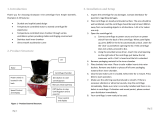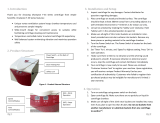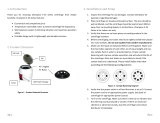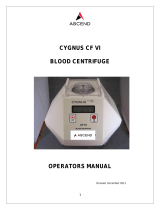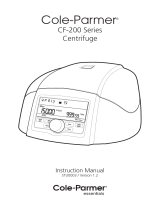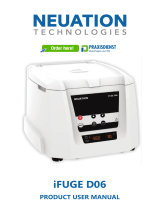Page is loading ...

Translation of the original operating manual
sb
07/2015
Rev. 1.12 of 16/07/2019
Sigma 2-7, Sigma 2-7 Cyto;Laboratory centrifuge;Sigma 2-7 IVD; ;
Laboratory centrifuge
part no. 0702802
Sigma 2-7, Sigma 2-7 Cyto
Sigma 2-7 IVD
from serial no. 157336
Laboratory centrifuge
Operating Manual
Please retain for later use!

Laboratory centrifuge Sigma 2-7, Sigma 2-7 Cyto
Laboratory centrifuge Sigma 2-7 IVD
2 / 68
Version 07/2015, Rev. 1.12 of 16/07/2019 • sb
Translation of the original operating manual, part no. 0702802

Laboratory centrifuge Sigma 2-7, Sigma 2-7 Cyto
Laboratory centrifuge Sigma 2-7 IVD
Version 07/2015, Rev. 1.12 of 16/07/2019 • sb
3 / 68
Translation of the original operating manual, part no. 0702802
© Copyright by
Sigma Laborzentrifugen GmbH
An der Unteren Söse 50
37520 Osterode am Harz
Germany
Tel.: +49 (0) 5522 / 5007-0
Fax: +49 (0) 5522 / 5007-12
Web: www.sigma-zentrifugen.de
E-mail: info@sigma-zentrifugen.de

Laboratory centrifuge Sigma 2-7, Sigma 2-7 Cyto
Laboratory centrifuge Sigma 2-7 IVD
4 / 68
Version 07/2015, Rev. 1.12 of 16/07/2019 • sb
Translation of the original operating manual, part no. 0702802

Laboratory centrifuge Sigma 2-7, Sigma 2-7 Cyto
Laboratory centrifuge Sigma 2-7 IVD
Table of contents
Version 07/2015, Rev. 1.12 of 16/07/2019 • sb
5 / 68
Translation of the original operating manual, part no. 0702802
1 General information ............................................................................................................. 9
1.1 Importance of the operating manual .................................................................................. 9
1.2 Intended use ..................................................................................................................... 9
1.3 Warranty and liability......................................................................................................... 9
1.4 Copyright ........................................................................................................................ 10
1.5 Standards and regulations .............................................................................................. 10
1.6 Scope of supply .............................................................................................................. 10
2 Layout and mode of operation .......................................................................................... 11
2.1 Layout of the centrifuge .................................................................................................. 11
2.1.1 Functional and operating elements ............................................................................ 11
2.1.2 Name plate ................................................................................................................ 12
2.2 Mode of operation ........................................................................................................... 13
2.2.1 Centrifugation principle .............................................................................................. 13
2.2.2 Area of application ..................................................................................................... 13
2.2.2.1 Speed, radius, and relative centrifugal force ...................................................... 14
2.2.2.2 Density ............................................................................................................... 14
3 Safety .................................................................................................................................. 15
3.1 Marking of the unit .......................................................................................................... 15
3.2 Explanation of the symbols and notes ............................................................................. 16
3.3 Responsibility of the operator .......................................................................................... 17
3.4 Operating personnel ....................................................................................................... 17
3.5 Informal safety instructions ............................................................................................. 17
3.6 Safety instructions .......................................................................................................... 18
3.6.1 Electrical safety ......................................................................................................... 18
3.6.2 Mechanical safety ...................................................................................................... 18
3.6.3 Fire prevention ........................................................................................................... 19
3.6.4 Chemical and biological safety .................................................................................. 19
3.6.5 Safety instructions for centrifugation .......................................................................... 20
3.6.6 Resistance of plastics ................................................................................................ 20
3.6.7 Safety of rotors and accessories ................................................................................ 21
3.6.7.1 Service life ......................................................................................................... 21
3.7 Safety devices ................................................................................................................ 21
3.7.1 Lid lock device ........................................................................................................... 21
3.7.2 Standstill monitoring system ...................................................................................... 22
3.7.3 System check ............................................................................................................ 22
3.7.4 Earth conductor check ............................................................................................... 22
3.8 Measures in the event of hazards and accidents ............................................................ 22
3.9 Remaining hazards ......................................................................................................... 22

Laboratory centrifuge Sigma 2-7, Sigma 2-7 Cyto
Laboratory centrifuge Sigma 2-7 IVD
Table of contents
6 / 68
Version 07/2015, Rev. 1.12 of 16/07/2019 • sb
Translation of the original operating manual, part no. 0702802
4 Storage and transport ....................................................................................................... 23
4.1 Dimensions and weight ................................................................................................... 23
4.2 Storage conditions .......................................................................................................... 23
4.3 Notes on transport .......................................................................................................... 23
4.4 Packaging ....................................................................................................................... 24
4.5 Transport safety device ................................................................................................... 24
5 Set-up and connection ...................................................................................................... 25
5.1 Installation site ................................................................................................................ 25
5.1.1 Type of connection .................................................................................................... 25
5.1.2 Customer-provided fuses ........................................................................................... 25
6 Using the centrifuge .......................................................................................................... 26
6.1 Initial start-up .................................................................................................................. 26
6.2 Switching the centrifuge on ............................................................................................. 26
6.2.1 Opening and closing the lid ........................................................................................ 26
6.2.2 Installation of rotors and accessories ......................................................................... 27
6.2.2.1 Installation of a rotor .......................................................................................... 27
6.2.2.2 Installation of accessories .................................................................................. 28
6.2.2.3 Adapters ............................................................................................................ 29
6.2.2.4 Vessels .............................................................................................................. 29
6.3 Control System "Spincontrol Basic" ................................................................................ 30
6.3.1 User interface ............................................................................................................ 30
6.3.2 Display ....................................................................................................................... 30
6.3.3 Starting a centrifugation run ....................................................................................... 31
6.3.4 Interrupting a centrifugation run ................................................................................. 31
6.3.5 Interrupting a deceleration process ............................................................................ 31
6.3.6 Speed / Relative centrifugal force (RCF) .................................................................... 31
6.3.6.1 Changing the speed/RCF value during centrifugation ........................................ 31
6.3.7 Runtime ..................................................................................................................... 32
6.3.7.1 Changing the runtime during centrifugation ........................................................ 32
6.3.7.2 Short run ............................................................................................................ 32
6.3.7.3 Continuous run................................................................................................... 32
6.3.8 Rotor selection ........................................................................................................... 33
6.3.9 Softstart and softstop function ................................................................................... 34
6.3.10 Automatic lid opening function ................................................................................... 34
6.3.11 Start delay ("Clotting time") ........................................................................................ 34
6.3.12 Sound signal .............................................................................................................. 35
6.3.13 Button signal .............................................................................................................. 35
6.3.14 Button lock ................................................................................................................. 35
6.3.15 Programs ................................................................................................................... 36
6.3.15.1 Saving the current settings ................................................................................. 36
6.3.15.2 Calling up stored programs ................................................................................ 36
6.4 Switching the centrifuge off ............................................................................................. 36

Laboratory centrifuge Sigma 2-7, Sigma 2-7 Cyto
Laboratory centrifuge Sigma 2-7 IVD
Table of contents
Version 07/2015, Rev. 1.12 of 16/07/2019 • sb
7 / 68
Translation of the original operating manual, part no. 0702802
7 Malfunctions and error correction .................................................................................... 37
7.1 General malfunctions ...................................................................................................... 37
7.1.1 Emergency lid release ............................................................................................... 38
7.2 Table of error codes ........................................................................................................ 39
7.3 Service contact ............................................................................................................... 40
8 Maintenance and service ................................................................................................... 41
8.1 Maintenance ................................................................................................................... 41
8.1.1 Centrifuge .................................................................................................................. 41
8.1.2 Accessories ............................................................................................................... 42
8.1.2.1 Plastic accessories ............................................................................................ 42
8.1.3 Rotors, buckets and carriers ...................................................................................... 43
8.1.4 Glass breakage ......................................................................................................... 43
8.2 Sterilisation and disinfection of the rotor chamber and accessories ................................ 44
8.2.1 Autoclaving ................................................................................................................ 45
8.3 Service ........................................................................................................................... 46
8.4 Return of defective centrifuges or parts .......................................................................... 47
9 Disposal .............................................................................................................................. 49
9.1 Disposal of the centrifuge ............................................................................................... 49
9.2 Disposal of the packaging ............................................................................................... 49
10 Technical data .................................................................................................................... 50
10.1 Ambient conditions ......................................................................................................... 51
10.2 Technical documentation ................................................................................................ 51
11 Appendix ............................................................................................................................ 52
11.1 Range of accessories ..................................................................................................... 52
11.1.1 Rotor radii .................................................................................................................. 52
11.2 Speed-gravitational-field-diagram ................................................................................... 53
11.3 Table of the service life of rotors and accessories ........................................................... 54
11.4 Resistance data .............................................................................................................. 55
11.5 EC declaration of conformity ........................................................................................... 59
11.6 Declaration of conformity – China RoHS 2 ...................................................................... 63
12 Index ................................................................................................................................... 65

Laboratory centrifuge Sigma 2-7, Sigma 2-7 Cyto
Laboratory centrifuge Sigma 2-7 IVD
Table of contents
8 / 68
Version 07/2015, Rev. 1.12 of 16/07/2019 • sb
Translation of the original operating manual, part no. 0702802

Laboratory centrifuge Sigma 2-7, Sigma 2-7 Cyto
Laboratory centrifuge Sigma 2-7 IVD
1 General information
Version 07/2015, Rev. 1.12 of 16/07/2019 • sb
9 / 68
Translation of the original operating manual, part no. 0702802
1 General information
1.1 Importance of the operating manual
A fundamental requirement for the safe and trouble-free operation of the
centrifuge is to be familiar with the fundamental safety instructions and all
possible hazards.
The operating manual includes important information concerning the safe
operation of the centrifuge.
This operating manual and, in particular, the notes on safety and hazards
must be observed by all persons operating the centrifuge.
In addition, the local rules and regulations for the prevention of accidents
must be complied with.
1.2 Intended use
The laboratory centrifuge is suitable for the separation of constituents of
different densities in mixtures with a maximum density of 1.2 g/cm
3
.
The laboratory centrifuge that is marked with IVD is intended for human
biological samples, including donated blood and tissue, in conjunction with
diagnostic in-vitro applications. This means that it is a medical product in
accordance with the IVD directive 98/79/EC.
Only trained, specialised personnel are authorised to use the centrifuge in
closed laboratories.
The intended use also includes:
• observation of all of the notes and instructions that are included in the
operating manual and
• compliance with the inspection and maintenance instructions.
Sigma Laborzentrifugen GmbH cannot be held liable for any damage
resulting from non-compliance.
1.3 Warranty and liability
The warranty and liability are subject to our "General Conditions" that were
distributed to the operator upon the conclusion of the contract.
Warranty and liability claims are excluded if they are due to:
• improper use.
• non-compliance with the safety instructions and hazard warnings in the
operating manual.
• improper installation, start-up, operation, or maintenance of the
centrifuge.

Laboratory centrifuge Sigma 2-7, Sigma 2-7 Cyto
Laboratory centrifuge Sigma 2-7 IVD
1 General information
10 / 68
Version 07/2015, Rev. 1.12 of 16/07/2019 • sb
Translation of the original operating manual, part no. 0702802
1.4 Copyright
The copyright concerning the operating manual remains with
Sigma Laborzentrifugen GmbH.
The operating manual is solely intended for the operator and their
personnel. It includes instructions and information that must not be
• duplicated,
• distributed, or
• communicated in any other way.
Non-compliance may be prosecuted under criminal law.
1.5 Standards and regulations
EC declaration of conformity
(see chapter 11.5 - "EC declaration of conformity")
1.6 Scope of supply
The centrifuge comprises:
• 1 power cord with IEC C13 connector
• 1 socket wrench, size 4 (rotor)
Part no. 930 050
• 1 socket wrench, size 6 (emergency release)
Part no. 930 056
Documentation
Operating manual incl. EC declaration of conformity
(see chapter 11.5 - "EC declaration of conformity")
Accessories
According to your order, our order confirmation, and your delivery note.

Laboratory centrifuge Sigma 2-7, Sigma 2-7 Cyto
Laboratory centrifuge Sigma 2-7 IVD
2 Layout and mode of operation
Version 07/2015, Rev. 1.12 of 16/07/2019 • sb
11 / 68
Translation of the original operating manual, part no. 0702802
2 Layout and mode of operation
2.1 Layout of the centrifuge
2.1.1 Functional and operating elements
1 Lid
2 Display
3 User interface
(see chapter 6.3.1 -
"User interface")
Fig. 1: Total view of the centrifuge
4 Fuse holder
5 Mains power switch
6 Name plate
(see chapter 2.1.2 -
"Name plate")
7 Mains power input
Fig. 2: Rear view of the centrifuge (example)

Laboratory centrifuge Sigma 2-7, Sigma 2-7 Cyto
Laboratory centrifuge Sigma 2-7 IVD
2 Layout and mode of operation
12 / 68
Version 07/2015, Rev. 1.12 of 16/07/2019 • sb
Translation of the original operating manual, part no. 0702802
2.1.2 Name plate
1 Manufacturer
2 Power consumption
3 Max. speed
4 Max. kinetic energy
5 Serial number
6 Part number
7 Nominal voltage
8 Type
9 Input fuse
10 CE mark in
compliance with the
directive 2006/42/EC
11 Symbol for special
disposal (see chapter
9 - "Disposal")
12 Consult operating
manual
13 Date of manufacture
14 IVD mark
(if applicable)
15 Max. permissible
density
Fig. 3: Example of a name plate

Laboratory centrifuge Sigma 2-7, Sigma 2-7 Cyto
Laboratory centrifuge Sigma 2-7 IVD
2 Layout and mode of operation
Version 07/2015, Rev. 1.12 of 16/07/2019 • sb
13 / 68
Translation of the original operating manual, part no. 0702802
2.2 Mode of operation
2.2.1 Centrifugation principle
Centrifugation is a process for the separation of heterogeneous mixtures of
substances (suspensions, emulsions, or gas mixtures) into their
components. The mixture of substances, which rotates on a circular path, is
subject to centripetal acceleration that is several times greater than the
gravitational acceleration.
Centrifuges use the mass inertia inside the rotor chamber for separating the
substances. Due to their higher inertia, particles or media with a higher
density travel outwards. In doing so, they displace the components with a
lower density, which in turn travel towards the centre.
The centripetal acceleration of an object inside a centrifuge, as the effect of
centripetal force, depends on the distance between the object and the axis
of rotation as well as on the angular velocity. It increases linearly as a
function of the distance with regard to the axis of rotation and quadratically
as a function of the angular velocity. The bigger the radius in the rotor
chamber is and the higher the speed is, the higher the centripetal
acceleration is. However, the forces acting on the rotor also increase.
Das
2.2.2 Area of application
Depending on the area of application of the centrifuge and also on the
particle size, solids content, and volume throughput of the mixture of
substances that is to be centrifuged, there are different types of centrifuges.
The areas of application go from household use as a salad spinner or
honey separator up to specialised technical applications in the clinical,
biological, or biochemical context:
• For numerous clinical examinations, cellular material must be separated
from the liquid to be analysed. The normal separation process can be
sped up considerably by using laboratory centrifuges.
• In the metal-working industry, centrifuges are used for separating oil
from metal cuttings. Dairies use centrifuges in order to separate cow’s
milk into cream and low-fat milk.
• Particularly big centrifuges are used in the sugar industry for separating
the syrup from the crystalline sugar.
• Ultracentrifuges are predominantly used in biology and biochemistry in
order to isolate particles, e.g. viruses. They are specifically designed for
high speeds up to 500,000 rpm. The rotor moves in a vacuum in order
to avoid air friction.

Laboratory centrifuge Sigma 2-7, Sigma 2-7 Cyto
Laboratory centrifuge Sigma 2-7 IVD
2 Layout and mode of operation
14 / 68
Version 07/2015, Rev. 1.12 of 16/07/2019 • sb
Translation of the original operating manual, part no. 0702802
2.2.2.1 Speed, radius, and relative centrifugal force
The acceleration g, which the samples are subject to, can be increased by
increasing the radius in the rotor chamber and by increasing the speed.
These three parameters are interdependent and linked with each other via
the following formula:
Relative centrifugal force RCF = 11.18 x 10-6 x r x n
2
r = radius in cm
n = speed in rpm
RCF without any dimension
If two values are entered, the third value is determined by way of the stated
formula. If, afterwards, the speed or the radius is changed, the resulting
relative centrifugal force will be recalculated automatically by the control
unit. If the RCF is changed, the speed will be adapted while the specified
radius is maintained.
The speed-gravitational-field-diagram provides an overview of the
relationship between speed, radius, and RCF (see chapter 11.2 - "Speed-
gravitational-field-diagram").
2.2.2.2 Density
The laboratory centrifuge is suitable for the separation of constituents of
different densities in mixtures with a maximum density of 1.2 g/cm
3
. All
information concerning the speed of rotors and accessories refers to liquids
with a density corresponding to this specification. If the density is above this
value, the maximum permissible speed of the centrifuge must be reduced
based on the following formula:
n = n
max
x
)/2,1( Rho
Rho = density in g/cm
3

Laboratory centrifuge Sigma 2-7, Sigma 2-7 Cyto
Laboratory centrifuge Sigma 2-7 IVD
3 Safety
Version 07/2015, Rev. 1.12 of 16/07/2019 • sb
15 / 68
Translation of the original operating manual, part no. 0702802
3 Safety
3.1 Marking of the unit
The following symbols are used for all types of centrifuges manufactured by Sigma:
Dangerous voltage
I
On (Power)
Hot surface
0
Off (Power)
Caution! Risk of bruising
Name plate (see chapter
2.1.2 - "Name plate")
Protective earth (ground)
CE mark in compliance with
the directive 2006/42/EC
Earth (ground)
Do not dispose as part of
domestic waste
Unplug the mains plug
Do not dispose as part of
domestic waste
g-lock
®
system installed
GS mark (tested safety; only
for Germany)
Arrow indicating the
direction of rotation
NRTL mark (only for the USA
and Canada)
4°C Guarantee
RCM mark
(only for Australia)
Centrifuge with heating
system
Medical product in
accordance with the IVD
directive 98/79/EC (In-vitro
diagnostica)
Rotor loading information
(see chapter 6.2.2.2 -
"Installation of
accessories")

Laboratory centrifuge Sigma 2-7, Sigma 2-7 Cyto
Laboratory centrifuge Sigma 2-7 IVD
3 Safety
16 / 68
Version 07/2015, Rev. 1.12 of 16/07/2019 • sb
Translation of the original operating manual, part no. 0702802
NOTE
Safety indications on the centrifuge must be kept readable at all times. If
necessary, they must be replaced.
NOTE
Not all of the symbols/labels are used for this centrifuge type.
3.2 Explanation of the symbols and notes
In this operating manual, the following names and symbols to indicate
hazards are used:
DANGER
This symbol stands for a direct hazard to the life and health of persons.
Non-observance of these symbols causes serious health problems up to
life-endangering injuries.
DANGER
This symbol stands for a direct hazard to the life and health of persons
due to electrical voltage.
Non-observance of these symbols causes serious health problems up to
life-endangering injuries.
WARNING
This symbol stands for a potential hazard to the life and health of persons.
Non-observance of these symbols can cause serious health problems up
to life-endangering injuries.
CAUTION
This symbol indicates a potentially hazardous situation
Non-observance of these notes can cause minor injuries or damage to
property.
NOTE
This symbol indicates important information.

Laboratory centrifuge Sigma 2-7, Sigma 2-7 Cyto
Laboratory centrifuge Sigma 2-7 IVD
3 Safety
Version 07/2015, Rev. 1.12 of 16/07/2019 • sb
17 / 68
Translation of the original operating manual, part no. 0702802
3.3 Responsibility of the operator
The operator undertakes to authorise only trained, specialised personnel to
work on the centrifuge (see chapter 3.4 - "Operating personnel").
The areas of responsibility of the personnel concerning the operation,
maintenance, and care of the unit must be clearly defined.
The safety-conscious work of the personnel in compliance with the
operating manual and the relevant EC health and safety directives, and the
national laws concerning health and safety and the prevention of accidents
must be checked at regular intervals (e.g. every month).
Under the international rules for health and safety at work, the operator is
obliged to:
• take measures in order to prevent danger to life or health during work.
• ensure that the centrifuges are used properly and entirely as intended
(see chapter 1.2 - "Intended use").
• take protective measures against fire and explosion when working with
hazardous substances.
• take measures for the safe opening of the centrifuges.
The operator must perform a risk assessment concerning potential
accidents in connection with the centrifuge and take design-related
countermeasures, if necessary.
The centrifuge has to be maintained regularly (see chapter 8 -
"Maintenance and service").
Components that are not in a perfect state must be replaced immediately.
3.4 Operating personnel
Only trained, specialised personnel are authorised to operate the unit. The
persons operating the unit must
• be familiar with the fundamental health, safety, and accident prevention
regulations.
• have read and understood this operating manual, in particular the safety
sections and warning notes, and confirmed this with their signature.
3.5 Informal safety instructions
• This operating manual is a part of the product.
• The operating manual must be kept at the location of use of the
centrifuge. Ensure that it is accessible at all times.
• The operating manual must be handed over to any subsequent owner
or operator of the centrifuge.
• Any changes, additions or updates received must be added to the
operating manual.
• In addition to the operating manual, the general and local rules and
regulations concerning the prevention of accidents and the protection of
the environment must also be supplied.
• Safety and danger indications on the centrifuge must be kept readable
at all times. If necessary, they must be replaced.

Laboratory centrifuge Sigma 2-7, Sigma 2-7 Cyto
Laboratory centrifuge Sigma 2-7 IVD
3 Safety
18 / 68
Version 07/2015, Rev. 1.12 of 16/07/2019 • sb
Translation of the original operating manual, part no. 0702802
3.6 Safety instructions
3.6.1 Electrical safety
To reduce the risk of electrical shock, the centrifuge uses a three-wire
electrical cord and plug to connect the equipment to earth-ground. To
preserve this safety feature:
DANGER
• Ensure that the wall socket is properly wired and grounded.
• Check that the mains voltage agrees with the nominal voltage listed on
the name plate.
• Do not place vessels containing liquid on the centrifuge lid or within the
safety distance of 30 cm around the centrifuge. Spilled liquids may get
into the centrifuge and damage electrical or mechanical components.
• Work on the power supply system must only be performed by certified
electricians.
• Inspect the electrical equipment of the unit regularly. Defects such as
loose or burnt cables must be eliminated immediately.
3.6.2 Mechanical safety
In order to ensure the safe operation of the centrifuge, observe the
following:
WARNING
• Do not open the lid when the rotor is in motion!
• Do not reach into the rotor chamber when the rotor is in motion!
• Do not use the centrifuge if it was installed incorrectly.
• Do not use the centrifuge without panels.
• Do not use the centrifuge if the rotors and inserts show signs of
corrosion or other defects.
• Only use the centrifuge with rotors and accessories that have been
approved by the manufacturer. In case of doubt, contact the
manufacturer (see chapter 7.3 - "Service contact").
• Do not hold your fingers between the lid and the housing when closing
the lid. Risk of crushing!
• Defective lid relieving devices could cause the centrifuge lid to fall
(contact the service department, if necessary). Risk of crushing!
• Do not hit or move the centrifuge during its operation.
• Do not lean against or rest on the centrifuge during its operation.
• Do not spin any substances that could damage the material of the
rotors and buckets of the centrifuge in any way. Highly corrosive
substances, for example, damage the material and affect the
mechanical strength of the rotors and buckets.
• Stop the centrifuge immediately in the event of a malfunction. Eliminate
the malfunction (see chapter 7 - "Malfunctions and error correction") or
inform the service department of the manufacturer (see chapter 7.3 -
"Service contact").
• Ensure that all repairs are performed only by authorised and
specialised personnel.

Laboratory centrifuge Sigma 2-7, Sigma 2-7 Cyto
Laboratory centrifuge Sigma 2-7 IVD
3 Safety
Version 07/2015, Rev. 1.12 of 16/07/2019 • sb
19 / 68
Translation of the original operating manual, part no. 0702802
WARNING
• Prior to any start-up, check the centrifuge, rotor, and accessories for
signs of damage that can be discerned from the outside. Special
attention must be paid to all of the rubber parts (e.g. motor cover, lid
seal, and adapters) in terms of visible structural changes. Defective
parts must be replaced immediately.
• Open the centrifuge when it is not in use so that moisture can
evaporate.
3.6.3 Fire prevention
DANGER
• Do not spin explosive or inflammable substances.
• Do not use the centrifuge within hazardous locations.
3.6.4 Chemical and biological safety
If pathogenic, toxic, or radioactive samples are intended to be used in the
centrifuge, it is in the responsibility of the user to ensure that all necessary
safety regulations, guidelines, precautions, and practices are adhered to
accordingly.
DANGER
• Infectious, toxic, pathogenic, and radioactive substances may only be
used in special, certified containment systems with a bio-seal in order
to prevent the material from being released.
• Take suitable precautions for your own safety if there is a risk of toxic,
radioactive, or pathogenic contamination
• Materials that chemically react with each other with a high level of
energy are prohibited.
WARNING
• Keep informed about local measures to avoid harmful emissions
(depending on the substances to be centrifuged).
• Protective clothing is not required for the operation of the centrifuge.
The materials to be centrifuged may, however, require special safety
measures (e.g. centrifugation of infectious, toxic, radioactive, or
pathogenic substances).

Laboratory centrifuge Sigma 2-7, Sigma 2-7 Cyto
Laboratory centrifuge Sigma 2-7 IVD
3 Safety
20 / 68
Version 07/2015, Rev. 1.12 of 16/07/2019 • sb
Translation of the original operating manual, part no. 0702802
3.6.5 Safety instructions for centrifugation
For safe operation, observe the following before starting the centrifuge:
WARNING
• Ensure that the centrifuge was set up properly (see chapter 5 - "Set-up
and connection").
• Maintain a safety distance of at least 30 cm (12 inches) around the
centrifuge.
• Do not store any dangerous goods in the centrifuge area.
• Do not stay in the safety area longer than what is absolutely necessary
for the operation of the centrifuge.
• Only use the centrifuge with rotors and accessories that have been
approved by the manufacturer. We explicitly warn against the use of
equipment of poor quality. Breaking glass or bursting vessels can
cause dangerous imbalances at high speeds
• Ensure that rotor and buckets are correctly fitted (see chapter 6.2.2.1 -
" Installation of a rotor ").
• Observe the instructions on the installation of accessories (see chapter
6.2.2.2 - "Installation of accessories").
WARNING
• The rotor must be loaded in a rotationally symmetrical manner at equal
weights.
• If liquids with a density > 1.2 g/cm
3
are used, reduce the speed (see
chapter 2.2.2.2 - "Density").
• Do not use the centrifuge if the rotor is loaded asymmetrically.
• Do not use the centrifuge with tubes that are excessively long.
3.6.6 Resistance of plastics
Chemical influences have a strong effect on the polymeric chains of
plastics, and, therefore, on their physical properties. Plastic parts can be
damaged if solvents, acids, or alkaline solutions are used.
NOTE
• Refer to the resistance data (see chapter 11.4 - "Resistance data")!
/
